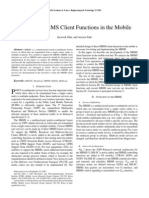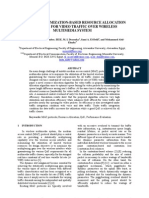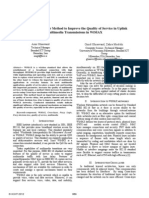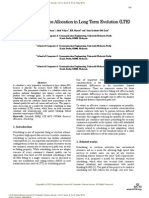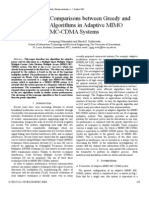MBMS Raptor Codes Design Trade-Offs For IPTV
MBMS Raptor Codes Design Trade-Offs For IPTV
Uploaded by
Firman Nico ChandraCopyright:
Available Formats
MBMS Raptor Codes Design Trade-Offs For IPTV
MBMS Raptor Codes Design Trade-Offs For IPTV
Uploaded by
Firman Nico ChandraOriginal Title
Copyright
Available Formats
Share this document
Did you find this document useful?
Is this content inappropriate?
Copyright:
Available Formats
MBMS Raptor Codes Design Trade-Offs For IPTV
MBMS Raptor Codes Design Trade-Offs For IPTV
Uploaded by
Firman Nico ChandraCopyright:
Available Formats
1264
IEEE Transactions on Consumer Electronics, Vol. 56, No. 3, August 2010
MBMS Raptor Codes Design Trade-offs for IPTV
Todor Mladenov, Student Member, IEEE, Saeid Nooshabadi, Senior Member, IEEE, and Kiseon Kim, Senior Member, IEEE
Abstract Raptor codes bring significant improvement to the performance of the forward error correction (FEC) scheme for 3rd Generation Partnership Program (3GPP) Multimedia Broadcast/Multicast Services (MBMS). They have become an integrated part of the fast growing mobile consumer services and technologies the multimedia content broadcast and delivery. In this work, we analyze the trade-offs involved in the implementation of systems employing MBMS. We show the performance for various packet erasure rates with fixed and variable Raptor code symbol overhead. We analyze the quality of service, for different block and symbol sizes and system throughputs. With the rise of new highly attractive but computationally intensive services, the lack of either the performance or the power in the mobile devices becomes a serious issue. We investigate the limiting effects of the Raptor decoder complexity on the performance of the mobile receiver system. Finally, we identify the system parameters that trade-off the Raptor coding performance for the decoding complexity1. Index Terms Raptor codes, MBMS, FEC, MTBF, HSDPA, IPTV, QoS.
I. INTRODUCTION The demand for multimedia services is rapidly growing, fueled by the substantial increase in the mobile internet traffic. Most popular and often delivered multimedia content includes the broadcasting of news, live sport events and concerts. Video streaming applications and services on mobile devices have been widely accepted as essential commodity. Moreover, the advances in the mobile technology are able to meet the need for higher quality streaming services. The need of an increasing number of clients to access the same content at the same time, led to the specification of a point-to-multipoint Multimedia Broadcast/Multicast Service (MBMS), by the 3rd Generation Partnership Program (3GPP) group [1]-[3]. In order to reduce the deployment costs, MBMS has come as an upgrade to the existing point-to-point packet based infrastructure of second and third generation wireless networks. Due to heterogeneous system and channel conditions, the physical layer forward error correction (FEC) schemes cannot provide sufficient reliability. Moreover,
additional packets are commonly lost, as a result of network congestions. In order to tackle these issues, MBMS provides a second, application layer FEC [4]. The nature of the point-tomultipoint transmission requires significant negotiation between the receivers and the sender. Applying an automatic repeat request (ARQ) retransmission mechanism, would explode the size of the feedback channel. For the efficient utilization of the available bandwidth, a feedback channel is not desirable at all. In order to increase the performance and guarantee quality of service (QoS), MBMS uses Raptor codes [5]-[7], in its application layer FEC. This study focuses on the practical aspects of the deployment of Raptor codes in the embedded consumer devices and services. We investigate the trade-offs in the network bandwidth utilization and computing complexity in the implementation of mobile multimedia services, such as digital video broadcasting (DVB), MBMS on embedded consumer devices. We show the system performance for the various packet erasure rates with fixed and variable code overheads. Further, we investigate the mean time between failure (MTBF), for different block and symbol sizes and system throughputs. We carry the analysis further by taking into account the limitations that the consumer handheld devices impose on the realization of Raptor codes. Particularly, we investigate the constraints on the Raptor codes from the computational and memory size limitations of embedded consumer devices. The paper is organized as follows. In section II we briefly introduce MBMS. Section III motivates the need of forward error correction with Raptor codes. Section IV analyzes the effect of the Raptor codes parameters on the performance of MBMS system. Section V presents the computational complexity versus the coding efficiency trade-offs in the design of the Raptor codes. Section VI concludes the paper. II. STREAMING SERVICES OVER MBMS 3GPP MBMS provides means for two main services: multimedia content streaming and data download delivery [6]. Fig. 1 shows the protocol stack for multimedia streaming services. The point-to-multipoint transmissions are supported by the protocols, carried by user datagram protocol (UDP) over internet protocol (IP). In this work we focus on the MBMS streaming services, where the delay time is subjected to strict constraint. In order to achieve the tight time margins, certain amounts of loss are acceptable. MBMS specifies H.264/AVC [2], [8] baseline profile as a preferred codec for video transmission. The main reasons for that are the high compression rates and its network friendly
1 T. Mladenov, and K. Kim are with the Department of Information and Communications, Gwangju Institute of Science and Technology (GIST), Gwangju 500-712, Republic of Korea, e-mail: {todor, kskim}@gist.ac.kr. S. Nooshabadi is with the Department of Electrical and Computer Engineering, Michigan Technological University, Houghton, MI, 49931, email: saeid@mtu.edu. This work was supported by The National IT Industry Promotion Agency of Korea. Contributed Paper Manuscript received 06/23/10 Current version published 09/23/10 Electronic version published 09/30/10. 0098 3063/10/$20.00 2010 IEEE
T. Mladenov et al.: MBMS Raptor Codes Design Trade-offs for IPTV
1265
video representation. Table I outlines some of the main video formats with H.264, used for IP based TV (IPTV). The peak downlink speed of Universal Mobile Telecommunication System (UMTS) networks is 384 kbps. With the use of High Speed Downlink Packet Access (HSDPA) [9] protocol, the top downlink rates can reach up to 21 Mbps.
Fig. 1. MBMS protocol stack for streaming services. TABLE I STANDARD IPTV VIDEO FORMATS WITH H.264 MODE QCIF QCIF CIF SDTV HDTV 128 kbps 192 kbps 2 Mbps 10 Mbps 20 Mbps Bit Rate 15.0 30.3 30.0 30.0 30.1 Frames/sec Frame Size 176144 176144 352288 720480 19201080 16 24 245 1,221 2,442 Packets/sec
source symbols of T-byte size. The source symbols are augmented by the Raptor encoder with any desired number of repair symbols. The repair symbols constitute the code overhead. Together, the source and repair symbols form a chunk of encoded data, ready for transmission. The encoded data chunks contain the original source symbols, due to the systematic nature of Raptor codes used by MBMS. The loss along the transmission path results in the reception of only a subset of the transmitted source and repair symbols. Raptor decoder can recover the original data from slightly more than K successfully received source and repair symbols. For the decoder only the number of the received symbols is relevant for the successful decoding. The symbols, received in excess of K source and repair symbols, are called the extra symbols. If no loss has occurred, no decoding is needed, as Raptor codes are systematic. In the case of packet loss, when the source block cannot be recovered, the receiver can use those source symbols, and the repair symbols, which were received correctly, to recover the source block symbols.
MBMS session consists of two phases. An initial phase, which announces and sets up the MBMS service, and a second delivery phase, which conveys the MBMS streaming. For the second face, the UDP protocol provides one way transport service, supporting data checksums and multiplexing. Nevertheless, it cannot guarantee the delivery of the data. There is no feedback channel to ensure the correct transmission. Furthermore, the transmit power level, the modulation type, or the data rate are not adaptively adjustable. Irreparably corrupted UDP packets are discarded by the physical and transport layer protocols. Those packets are declared lost, together with the ones which are not received, due to limited coverage or loss of signal. In order to recover those lost packets, MBMS employs application layer FEC with Raptor codes [5]-[7]. III. FORWARD ERROR CORRECTION WITH RAPTOR CODES FEC at the application layer adds redundant repair packets to the source data packets. It allows the receiver to recover lost data at the expense of information transmission rate. Due to the lack of feedback channel, this is the only way to provide error protection, and transmission system reliability. MBMS has adopted Raptor codes [5]-[7] for its application layer FEC. It is due to the excellent properties of Raptor codes; most importantly, the ability to generate as many repair symbols as needed on-the-fly. They are capacity achieving codes with linear encoding and decoding times. Additionally, the Raptor decoder over binary erasure channels (BEC) has a relatively lower complexity, compared to the alternative schemes. The Raptor FEC encoder divides the transmission data into segments, called source blocks. Each block is formed by K
Fig. 2. Double buffer application layer FEC decoding.
Fig. 2 shows the mechanism for the application layer FEC Raptor decoding at the receiver side. In general each source block and its associated repair symbols are pre-buffered prior to decoding. The available decoding time is the time needed for the reception of the next block. Raptor decoder algorithms for BEC are efficient and have been reported to perform well on workstations with a negligible decoding time [6]. However, on the embedded mobile systems, such as the majority of the MBMS receivers, the decoding time is not insignificant and may in fact span beyond the available time. This is even more so at high data rates required for CIF, SDTV and HDTV. The performance of the streaming MBMS services depends significantly on the performance of the FEC Raptor codes. The source block size K, the amount of repair symbols, the size of the symbols T, the amount of symbol overhead are set according to the estimated network and channel conditions, the desired QoS, the available bandwidth, and the receivers computational power. The trade-offs which arise are analyzed and discussed in the following sections. To highlight the trade-offs between transmission bandwidth and the decoding time on a resource constrained mobile platform, all experiments are conducted on a representative embedded system 2.
2 The embedded system platform, chosen for the evaluation purposes, is a 100 MHz NIOS II soft-core processor, running on an EP3SL150F1152 Stratix III FPGA (field-programmable gate array).
1266
IEEE Transactions on Consumer Electronics, Vol. 56, No. 3, August 2010
IV. ANALYSIS OF RAPTOR CODES FOR MBMS The real-time transport protocol (RTP) defines a standardized packet format for delivering multimedia over IP. The RTP packets form source blocks, indentified by source block numbers (SBN), at the application layer FEC layer [7]. Each source block has K number of T-byte size symbols, as mentioned before. The position of a symbol within a block is determined by its encoded symbol ID (ESI). The source blocks are processed by the FEC Raptor code to generate repair symbols of the same T-byte size. The FEC layer source and repair symbols are partitioned into packets that are encapsulated separately at the UDP layer and sent to different UDP ports. Each UDP layer packet with payload of 1024 bytes contains one or more encoded symbols of size T.
Fig. 4. Available extra symbols at the receiver, for block size of K=128 and various symbol sizes of (T=128, 256, 512, and 1024). The transmitted repair symbol overhead is fixed at 30%.
Fig. 4 presents the effects of symbol size on the performance of MBMS FEC. Here the source symbol block size is fixed at K=128; the most critical case in Fig. 3. With the increase of the symbol size, there is only a marginal improvement in the available number of extra symbols at the receiver side. The effect of larger symbol sizes is better noticeable at higher packet erasure rates. Nevertheless, Raptor decoder cannot guarantee successful data recovery for erasure rates higher than 12%, for K=128, irrespective of T.
Fig. 3. Available extra symbols at the receiver, for various source block sizes of (K=128, 256, 512, and 1024), for the symbol size of T=128. The transmitted repair symbol overhead is fixed at 30%.
A. Fixed Overhead It is shown in [10] that the larger block sizes K utilize the available bandwidth more efficiently. This is because the overhead in the number of repair symbols is a smaller fraction of the block size as K grows. Additionally, the data in [10] show that at most K + 17 source and repair symbols guarantee a successful decoding. Moreover, the mean value of the number of extra symbols, for a successful decoding, is relatively independent of the source symbol erasure rate and of the source symbol block size K. Fig. 3 and Fig. 4 demonstrate the behavior of MBMS system under a fixed FEC Raptor code overhead of 30%. This means that the amount of repair symbols, sent by the transmitter, is fixed to 30% of the source block symbols. It is equivalent to an effective bandwidth reduction of 27%. In Fig. 3 the symbol size T is fixed at 128 bytes. For the block size of 128 source symbols, the Raptor decoder will not be able to guarantee a successful decoding, when the packet erasure rates are higher than 12%. This is because the number of extra received symbols is not enough [10]. For the case of K=256, successful decoding can be guaranteed for packet erasure rates up to 16%. With larger source block sizes, Raptor codes are able to guarantee successful data recovery, for much higher packet erasure rates, for the same rate of repair symbol overhead.
Fig. 5. MTBF in seconds for various source symbol sizes, expressed in KB, with different amount of extra symbols, with 20% symbol erasure rate, for a bearer speed of 384 kbps.
B. Meantime between Failure (MTBF) For a bearer speed of 384 kbps, and for 20% symbol erasure rate, Fig. 5 shows MTBF in seconds, as a measure of the likelihood of error in the decoding of a source block, for various source data block sizes. The plots present the QoS that can be achieved with certain amount of extra symbols in addition to K source and repair symbols. The combinations of the K and T values used in the plots of Fig. 5 are (T=128, 256, 512, 1024, and K=1024) and (T=128, and K=512, 256, and 128). The packet erasure rate is fixed at 20%, which is considered typical for MBMS applications. The plots in Fig. 5 confirm the observations previously made about the extra repair symbols. More number of extra symbols leads to a higher probability of successful decoding or longer MTBF.
T. Mladenov et al.: MBMS Raptor Codes Design Trade-offs for IPTV
1267
MTBF increases linearly with the block size, whereas it increases exponentially with the number of extra symbols. C. Bandwidth vs. Symbol Overhead Next, we analyze the relation between the bandwidth and the QoS. The packet erasure rates vary from 0% to 20%. The bearer speed is set to 384 kbps. The QoS that we want to maintain in Fig. 6 is at most one unsuccessful decoding of source block per hour. This is equivalent to MTBF of 3600 second. The symbol size T is fixed at 128 bytes. Without any packet erasures, the whole bearer bandwidth is available for the source data packets. No repair packets are necessary.
reason for that behavior follows from the exponential dependence of MTBF on the number of extra symbols as previously was noted in relation to the plots of Fig. 5.
Fig. 7. Data throughput for various packet erasure rates and block sizes of (K=128, 256, 512 and 1024) for T=1024, with the desired MTBF QoS of 1 dropped source block per hour.
V. RAPTOR DECODING COMPLEXITY ISSUES A. FEC Raptor Decoding Time in Software In the preceding discussions we showed that using a large source block sizes K, for the Raptor codes in MBMS FEC, achieves better bandwidth utilization. In this section we analyze the computational complexity of the FEC Raptor decoder. The block decoding starts as soon as all source and repair symbols, belonging to the current block and not erased by the channel, have been received. From Fig. 2, the decoding time of block i is limited to the time for the reception of block i+1. The idle time P is the difference between the arrival time of block i+1, and the decoding time of block i. The most complex and time consuming operation in the Raptor decoder is the pre-code matrix inversion [11]. The suboptimal message passing (MP) decoding algorithms have low complexity but require significant symbol overhead. On the other hand, at the expense of higher complexity the decoding can be performed with the standard Gaussian elimination (GE) algorithm. However for the practical implementations of MBMS Raptor decoding over BEC, it is recommended not use either of the suboptimal MP or the standard GE algorithms, and instead use the MBMS standard algorithm (SA), specified in [7]. The FEC Raptor decoding time with the GE algorithm, for different block sizes (K T in KBs) is shown in Fig. 8. We assume the repair symbol overhead is sufficient for a successful decoding with MTBF of 3600 second. The packet erasure rate is assumed to be 20%. The bearer speed is set to 384 kbps. For each block size in KB, the symbol size T is determined by its corresponding K value (K=128, 256, 512, and 1024 symbols). The idle times (P) are indicated above the bars. A positive idle time, means that the previous block decoding is able to finish before the end of the reception of the current data block. On the other hand, a negative idle time indicates that the decoder cannot handle those particular combinations of K and T, within the specified time slot. While there are enough extra symbols
Fig. 6. Data throughput for various packet erasure rates and block sizes of (K=128, 256, 512 and 1024) for T=128, with the desired MTBF QoS of 1 dropped source block per hour.
With the increase in the packet erasure rate in Fig. 6, the available bandwidth for the source symbols starts to decrease. The required repair symbol overhead increases the most for K=128. Raptor codes with larger block sizes require significantly less repair symbols overhead to maintain the desired QoS. This result is easily recognized from the plots of Fig. 6. At 20% packet erasure rate the available bandwidth reduces to 67%, 74%, 78%, and 79% of the bearer bandwidth of 384 kbps, for K=128, 256, 512, and 1024 source block sizes, respectively. Fig. 7 gives the effective bandwidth, when the symbol size is T=1024 bytes. At this value of T, the gaps between the plots have reduced, as compare to the plots for T=128 in Fig. 6. Again, the required symbol overhead increases linearly with the increase in the packet erasure rate, for all K values. At 20% packet erasure rate the available bandwidth reduces to 74%, 77%, 79%, and 80% of the bearer bandwidth of 384 kbps, for K=128, 256, 512, and 1024 source block sizes, respectively. The highest improvement, in going from T=128 to T=1024 bytes, is for source block size of K=128. For larger block sizes the effect of T is much less significant. Overall, the source block size K has a larger impact on the required repair symbols overhead, compared to the symbol size T. So we conclude that best bandwidth efficiency can be achieved by using the maximum values of both K and T. When the required QoS is reduced to MTBF of 60 seconds, the required symbol overhead decreases at most with 1.8%, compared to the corresponding MTBF of 3600 second. The
1268
IEEE Transactions on Consumer Electronics, Vol. 56, No. 3, August 2010
available for the successful decoding, the available time for decoding is insufficient.
Fig. 8. FEC Raptor decoding with GE. The numbers above the bars show the idle times P.
complexity of Raptor codes. The data show that we are able to improve the decoding performance of the Raptor codes by choosing smaller values of K, and larger values of T. However, this comes at the expense of higher bearer bandwidth. We note from Table II that with the largest T value of 1024 bytes, the best decoding throughput of 969 kbps is achieved for the case of the lowest value of K=128. For the packet erasure rate of 20% and MTBF of 3600 seconds, this requires a bearer bandwidth of 1,333 kbps; an overhead of 38%. Noting from Fig 7, this corresponds to the least efficient code combination of K and T. On the other hand, for the most code efficient case of T=1024 and K=1024 in Fig 7, where both K and T are the largest, the decoding throughput is 410 kbps. This corresponds to a bear bandwidth of 512 kbps; an overhead of 26%. Further, from the combinations of Fig. 6, Fig. 7 and Table II we also note that from both coding efficiency and computational complexity points of view, small values of T should be avoided, irrespective of the value of K chosen.
TABLE II DECODING THROUGHPUT VS. BEARER BANDWIDTH T 128 1024 K 128 256 512 1024 128 256 512 1024 Decoding Throughput 349 261 152 87 969 853 588 410 (kbps) Required Bearer 523 352 194 110 1,333 1,121 751 516 Bandwidth (kbps) 50 34 28 27 38 31 28 26 Overhead (%)
Fig. 9. FEC Raptor decoding with SA. The numbers above the bars show the idle times P.
GE is able to decode block sizes K of 128 and 256 symbols for all values of T. For two out of the four cases when K=512, and all four cases when K=1024 symbols, GE fails to decode the block of data, within the designated time slot. This is due to the computational complexity of the matrix inversion that increases cubically with K. Therefore, while large symbol block sizes K provide better utilization of the bearer bandwidth, they require significant computational resources. Similar plots for Raptor decoding with the SA algorithm are shown in Fig. 9. The GE algorithm provides larger idle times than the SA algorithm for all considered values K, as long as T is less than 512 [11]. On the other hand, SA is able to decode the data within the designated time for the symbol size T=1024 bytes, for all K values considered, including the most bandwidth efficient case of T=1024 and K=1024, among all the combinations considered in Fig. 6 and Fig. 7. The SA algorithm takes the advantage of the sparsity of the pre-code matrix [11]. Further, SA has been designed to require less row Exclusive-Or operations. Therefore, it is able to significantly reduce the decoding time for the large symbol sizes. B. Decoding Throughput vs. Bearer Bandwidth Using the decoding time information from Fig 9, we can construct the data in Table II. It highlights the trade-offs between the communication link overhead and decoding
C. FEC Raptor Decoding with Hardware Accelerator The bearer data throughput can reach up to 21 Mbps when HSDPA is used. At that speed the network can provide a high definition video streaming. From the plots in Fig. 8 and Fig. 9, it is apparent that the embedded processor cannot handle the MBMS FEC Raptor decoding at such high rates, no matter what combination of K and T are chosen. One possible solution is the use of dedicated matrix inversion hardware accelerator. In [11] it is shown that GE is better suited for hardware implementation. It significantly outperforms SA. Fig. 10 shows the performance of the hardware accelerator from [11], which processes data using a 128-byte parallel processor. Larger symbol sizes are processed sequentially using 128-byte chucks. The data in Fig. 10 is acquired for MTBF of 3600 seconds and packet erasure rate of 20%. The numbers above the bars show the exact decoding throughputs. The highest throughput is achieved with the source block size of K=128 and T=1024, where the hardware accelerator achieves maximum throughput of 8.61 Mbps. For this value of K, the throughput rises almost twice from T=128 to T=1024, due to the parallel processing. The throughput decreases significantly for the higher values of block size (K=256, 512, and 1024). Unfortunately, as noted from Fig. 6, and Fig. 7 and Table II, the case of K=128 and T=1024 does not correspond to the most bandwidth efficient combination. For a 3.53 fold decrease in the decoding throughput, we will have the most bandwidth efficient combination of K=1024 and T=1024. At
T. Mladenov et al.: MBMS Raptor Codes Design Trade-offs for IPTV
1269 A. Shokrollahi, Raptor codes, IEEE Trans. Inf. Theory, vol. 52, pp. 2551-2567, June 2006. [6] M. Luby, M. Watson, T. Gasiba, T. Stockhammer, and W. Xu, Raptor Codes for reliable download delivery in wireless broadcast systems, in Proc. of Consumer and Communications Networking Conference (CCNC), Las Vegas, NV, USA, January 2006. [7] 3GPP TS 26.346, Technical Specification Group Services and System Aspects; Multimedia Broadcast/Multicast Services (MBMS); Protocols and codecs, ETSI, Rev. V7.4.1, June 2007. [8] M. von dem Knesebeck, and P. Nasiopoulos, "An efficient earlytermination mode decision algorithm for H.264," IEEE Trans. Consumer Electron., vol.55, no.3, pp.1501-1510, August 2009. [9] D. Gomez-Barquero, A. Fernandez-Aguilella, and N. Cardona, Multicast delivery of file download services in evolved 3G mobile networks with HSDPA and MBMS, IEEE Transactions on Broadcasting, vol. 55, no. 4, pp. 742-751, December 2009. [10] T. Mladenov, S. Nooshabadi, and K. Kim, Strategies for the design of Raptor decoding in broadcast/multicast delivery systems, IEEE Trans. Consumer Electron., vol.54, no.2, May 2010. [11] T. Mladenov, S. Nooshabadi, A. Dassatti, and K. Kim, Parallel scalable hardware architecture for hard raptor decoder, IEEE International Symposium on Circuits and Systems (ISCAS), May 2010, Paris, France. BIOGRAPHIES Todor Mladenov (M06) received the B.E. degree in communications and communications technologies from Technical University Sofia, Bulgaria, in 2005, and the M.S. degree in information and communications from Gwangju Institute of Science and Technology (GIST), Republic of Korea, in 2007. Currently, he is a Ph.D. candidate at GIST with the department of Information and Communications. His research interests include the design of low power, high speed application specific circuits and systems for multimedia, communications and information theory, channel coding and computing in its broad sense. Saeid Nooshabadi received the MTech and PhD degrees in electrical engineering from the India Institute of Technology, Delhi, India, in 1986 and 1992, respectively. Currently, he is a professor in Computer Engineering Systems in the Department of Electrical and Computer Engineering, Michigan Technological University, Houghton MI. Prior to his current appointment he was with the Department of Information and Communications, Gwangju Institute of Science and Technology, Republic of Korea (2007-2010), and with the School of Electrical Engineering and Telecommunications, University of New South Wales, Sydney, Australia (2000-2007). In 1992, he was a Research Scientist at the CAD Laboratory, Indian Institute of Science, Bangalore, India, working on the design of VLSI chips for TV ghost cancellation in digital TV. In 1996 and 1997, he was a Visiting Faculty and Researcher, at the Center for Very High Speed Microelectronic Systems, Edith Cowan University, Western Australia, working on high performance integrated circuits; and Curtin University of Technology, Western Australia, working on the design of high speed-high frequency modems. His research interests include very high-speed integrated circuit (VHSIC) and application-specified integrated circuit design for high-speed telecommunication and image processing systems, low-power design of circuits and systems, and low-power embedded systems. Kiseon Kim received the B.Eng. and M.Eng. degrees, in electronics engineering, from Seoul National University, Korea, in 1978 and 1980, and the Ph.D. degree in electrical engineering-systems from University of Southern California, Los Angeles, in 1987. From 1988 to 1991, he was with Schlumberger, Houston, Texas. From 1991 to 1994, he was with the Superconducting Super Collider Lab, Texas. He joined Gwangju Institute of Science and Technology (GIST), Korea, in 1994, where he is currently a professor. His current interests include wideband digital communications system design, sensor network design, analysis and implementation both at the physical layer and at the resource management layer. [5]
the expense of 2% decrease in the bandwidth efficiency, we can choose the combination of K=512 and T=1024, and only drop the throughput by factor of 2.45.
Fig. 10. Maximum decoding throughput with hardware accelerated GE. The numbers above the bars show the exact throughput values.
D. Latency and Memory Utilization An important consideration for consumer devices, when choosing larger K and T values, is the latency and the memory requirements. For example, with the double buffering strategy in Fig. 2, and K=T=1024, the decoder would require a minimum memory of 2.1 MB, just for the Raptor decoder. Moreover, even if the software Raptor decoder is able to handle those large values of K and T within the required time slot, it will lead to a perceptible delay of about 47 seconds before the actual playback can begin; affecting the user experience. VI. CONCLUSION In this work we analyzed the system trade-offs for an MBMS with Raptor codes. We showed that the MTBF increases exponentially with the amount of the extra received symbols. It was demonstrated that larger source block sizes achieve much better bearer bandwidth utilization. Moreover, for a desired MTBF, the amount of repair symbol overhead is independent of the source block size. Nevertheless, it was found that under optimal decoding algorithms for BEC, large source symbol sizes experience significant computational complexity. This underscores the trade-offs between communication link efficiency and computational complexity of the Raptor codes. To overcome the throughput limitations of the software decoding, a case for a dedicated hardware matrix inversion accelerator was made. REFERENCES
[1] [2] [3] [4] 3GPP TS 23.246, Technical Specification Group Services and System Aspects; Multimedia Broadcast/Multicast Services (MBMS); Architecture and functional description, ETSI, Rev. V9.4.0, Mar. 2010. J. Afzal, T. Stockhammer, T. Gasiba, and W. Xu, Video streaming over MBMS: A system design approach, Journal of Multimedia, vol. 1, no. 5, August 2006. J. Kim, J. Cho, and H. Shin, "Layered resource allocation for video broadcasts over wireless networks," IEEE Trans. Consumer Electron., vol.54, no.4, pp.1609-1616, November 2008. S. W. Kim, S. Y. Kim, S. Kim, and J. Heo, Performance analysis of forward error correcting codes in IPTV, IEEE Trans. Consumer Electron., vol. 54, no. 2, pp. 376-380, May 2008.
You might also like
- Mid Face Rejuvenation PDFDocument3 pagesMid Face Rejuvenation PDFAlan LongNo ratings yet
- M2M Communication Scheduling Techniques Using LTE/LTE-A: Ali Ghubaish (A Paper Written Under The Guidance ofDocument14 pagesM2M Communication Scheduling Techniques Using LTE/LTE-A: Ali Ghubaish (A Paper Written Under The Guidance ofNoobstaxD AhmedNo ratings yet
- AL-FEC For Streaming Services in LTE E-MBMSDocument12 pagesAL-FEC For Streaming Services in LTE E-MBMSmohammed5wesabiNo ratings yet
- Reliable Multimedia Download Delivery inDocument12 pagesReliable Multimedia Download Delivery inAMAN YADAV 20BEE0350No ratings yet
- Performance Analysis of Uncoded & Coded Ofdm System For Wimax NetworksDocument5 pagesPerformance Analysis of Uncoded & Coded Ofdm System For Wimax NetworksInternational Journal of Application or Innovation in Engineering & ManagementNo ratings yet
- MPEG-4 Performance Analysis For A CDMA Network-on-Chip: Manho Kim, Daewook Kim and Gerald E. SobelmanDocument4 pagesMPEG-4 Performance Analysis For A CDMA Network-on-Chip: Manho Kim, Daewook Kim and Gerald E. SobelmanraghavaNo ratings yet
- Application of Multiple Description Coding in 4G Wireless Communication SystemsDocument6 pagesApplication of Multiple Description Coding in 4G Wireless Communication SystemsSherif MaherNo ratings yet
- Dynamic Code Assignment in Hybrid MC-CDMA/TDMA System: BstractDocument6 pagesDynamic Code Assignment in Hybrid MC-CDMA/TDMA System: BstractKevin AlberitNo ratings yet
- A Multiple Access Protocol For Multimedia Transmission Over Wireless NetworksDocument17 pagesA Multiple Access Protocol For Multimedia Transmission Over Wireless NetworksAIRCC - IJCNCNo ratings yet
- New Elements in Vehicle Communication "Media Oriented Systems Transport" ProtocolDocument5 pagesNew Elements in Vehicle Communication "Media Oriented Systems Transport" ProtocolMADDYNo ratings yet
- Ijcnc 050313Document13 pagesIjcnc 050313AIRCC - IJCNCNo ratings yet
- Multimedia Broadcast Multicast Service, MBMSDocument24 pagesMultimedia Broadcast Multicast Service, MBMSAsadKhanNo ratings yet
- Performance Analysis For Qos-Aware Two-Layer Scheduling in Lte NetworksDocument6 pagesPerformance Analysis For Qos-Aware Two-Layer Scheduling in Lte NetworksInternational Journal of Application or Innovation in Engineering & ManagementNo ratings yet
- UBICC Paper 99 (1) 99Document7 pagesUBICC Paper 99 (1) 99Ubiquitous Computing and Communication JournalNo ratings yet
- Design of MBMS Client Functions in The Mobile: Jaewook Shin, and Aesoon ParkDocument4 pagesDesign of MBMS Client Functions in The Mobile: Jaewook Shin, and Aesoon ParkShifaiz MohamedNo ratings yet
- LTE Radio Bearer QoSDocument8 pagesLTE Radio Bearer QoSqevedouNo ratings yet
- S2-08wxyz 23.246 CRDocument4 pagesS2-08wxyz 23.246 CRsoueeeNo ratings yet
- Journal 1Document4 pagesJournal 1Dee MatNo ratings yet
- Fair Downlink Scheduling AlgorithmDocument8 pagesFair Downlink Scheduling AlgorithmsugadoorNo ratings yet
- Qam ThesisDocument4 pagesQam ThesisMichelle Shaw100% (1)
- Telecom Interactive 97Document22 pagesTelecom Interactive 97abhi_protocol123No ratings yet
- Video Streaming Over MBMS A System DesignDocument11 pagesVideo Streaming Over MBMS A System DesignSiva Bhaskar ReddyNo ratings yet
- UNIT3NGNDocument5 pagesUNIT3NGNshubham chauhanNo ratings yet
- Qos Spie03.PsDocument14 pagesQos Spie03.PsumarhidayatNo ratings yet
- UBICC Paper 64 (1) 64Document12 pagesUBICC Paper 64 (1) 64Usman TariqNo ratings yet
- LTE EPC Technology EssentialsDocument26 pagesLTE EPC Technology EssentialsAmit MishraNo ratings yet
- MPLSTP Based Mobile Backhaul Networks 572Document18 pagesMPLSTP Based Mobile Backhaul Networks 572stojancolicNo ratings yet
- Characterization by Measurement of A CDMA 1x EVDO NetworkDocument8 pagesCharacterization by Measurement of A CDMA 1x EVDO NetworkMukul JuyalNo ratings yet
- Two-Level Downlink Scheduling For Real-Time Multimedia Services in LTE NetworksDocument31 pagesTwo-Level Downlink Scheduling For Real-Time Multimedia Services in LTE NetworkstestNo ratings yet
- Ascom Network Testing - Available Bandwidth Measurements Technical PaperDocument12 pagesAscom Network Testing - Available Bandwidth Measurements Technical PaperKensenhuis JimmyNo ratings yet
- UBICC Paper 99 (1) 99Document7 pagesUBICC Paper 99 (1) 99Usman TariqNo ratings yet
- Forward ErrorDocument15 pagesForward Errorvarun1812eduNo ratings yet
- Throughput Analysis For Video Transmission in Lte Downlink: Luxy Mathews, Princy P. Jayan & Sakuntala S. PillaiDocument8 pagesThroughput Analysis For Video Transmission in Lte Downlink: Luxy Mathews, Princy P. Jayan & Sakuntala S. PillaiTJPRC PublicationsNo ratings yet
- A Composite Packet Scheduling Algorithm For LTE DownlinkDocument15 pagesA Composite Packet Scheduling Algorithm For LTE DownlinkDahiru Sani Shu'aibuNo ratings yet
- 14 FountaincodeDocument7 pages14 FountaincodeToàn - K2 Nguyễn VănNo ratings yet
- 11561-Article Text-20520-1-10-20211119Document8 pages11561-Article Text-20520-1-10-20211119kaanNo ratings yet
- Ijarets V-2-3-13Document9 pagesIjarets V-2-3-13swapnil tiwariNo ratings yet
- 3 Egprs Technology: Edge Basics, Version 1.5 T.O.P Businessinteractive GMBH Page 1 of 20Document20 pages3 Egprs Technology: Edge Basics, Version 1.5 T.O.P Businessinteractive GMBH Page 1 of 20likameleNo ratings yet
- Understanding Carrier Ethernet ThroughputDocument22 pagesUnderstanding Carrier Ethernet Throughputexplorenet7No ratings yet
- 3 Egprs Technology: Edge Basics, Version 1.5 T.O.P Businessinteractive GMBH Page 1 of 20Document20 pages3 Egprs Technology: Edge Basics, Version 1.5 T.O.P Businessinteractive GMBH Page 1 of 20mailsianNo ratings yet
- Interaction Between UMTS MAC Scheduling and TCP Flow Control MechanismsDocument4 pagesInteraction Between UMTS MAC Scheduling and TCP Flow Control MechanismsanmolgksNo ratings yet
- A Fuzzy Cross-Layer Method To Improve The Quality of Service in Uplink Multimedia Transmissions in WimaxDocument6 pagesA Fuzzy Cross-Layer Method To Improve The Quality of Service in Uplink Multimedia Transmissions in WimaxmathewkylescribdNo ratings yet
- Codeword To Layer Mapping For Multiple Layers MIMO Systems: January 2010Document6 pagesCodeword To Layer Mapping For Multiple Layers MIMO Systems: January 2010Bhaskar KarimuriNo ratings yet
- UMTS Radio Resource Management by Transport Format Assignment and SelectionDocument5 pagesUMTS Radio Resource Management by Transport Format Assignment and SelectionJie YangNo ratings yet
- LTE E-MBMS Capacity and Intersite Gains: Américo Correia, Rui Dinis, Nuno Souto, and João SilvaDocument23 pagesLTE E-MBMS Capacity and Intersite Gains: Américo Correia, Rui Dinis, Nuno Souto, and João SilvaIgor MalianovNo ratings yet
- Strategies For Fast Scanning and Handovers in Wimax/802.16Document7 pagesStrategies For Fast Scanning and Handovers in Wimax/802.16marcial714No ratings yet
- The Interaction Between The DOCSIS 1.1/2.0 MAC Protocol and TCP Application PerformanceDocument10 pagesThe Interaction Between The DOCSIS 1.1/2.0 MAC Protocol and TCP Application Performancecharm23No ratings yet
- Qos Criteria in Ieee 802.16 Collision Resolution Protocol: Abdelillah Karouit and Abdelkrim Haqiq Luis Orozco BarbosaDocument7 pagesQos Criteria in Ieee 802.16 Collision Resolution Protocol: Abdelillah Karouit and Abdelkrim Haqiq Luis Orozco BarbosaMahri PriyatnoNo ratings yet
- GSM RF Interview QuestionsDocument26 pagesGSM RF Interview QuestionsmohammedelrabeiNo ratings yet
- Qoe-Based Transport Optimization For Video Delivery Over Next Generation Cellular NetworksDocument6 pagesQoe-Based Transport Optimization For Video Delivery Over Next Generation Cellular NetworksrishikarthickNo ratings yet
- CopieDocument5 pagesCopiemekbelfouzia03No ratings yet
- Downlink Resource Allocation in Long Term Evolution (LTE) : KeywordsDocument6 pagesDownlink Resource Allocation in Long Term Evolution (LTE) : Keywordsmykeenzo5658No ratings yet
- Ceragon - Jumbo Frames - Technical BriefDocument7 pagesCeragon - Jumbo Frames - Technical BriefBernardo PortillaNo ratings yet
- Chapter Eight Network Control and Monitoring: Circuit SwitchingDocument7 pagesChapter Eight Network Control and Monitoring: Circuit Switchingshavali56No ratings yet
- Fast ARQ in High Speed Downlink Packet Access For WCDMA SystemsDocument7 pagesFast ARQ in High Speed Downlink Packet Access For WCDMA SystemsTorsion TesnorNo ratings yet
- Internet Technology Assignment 1Document7 pagesInternet Technology Assignment 1Emily HaNo ratings yet
- Improved Automotive CAN Protocol Based On PayloadDocument15 pagesImproved Automotive CAN Protocol Based On PayloadMoises Antonio CarneiroNo ratings yet
- Modeling E-Mail Traffic For 3G Mobile Networks: (Psvoboda, Wkarner, Mrupp) @NT - Tuwien.ac - atDocument5 pagesModeling E-Mail Traffic For 3G Mobile Networks: (Psvoboda, Wkarner, Mrupp) @NT - Tuwien.ac - at060319No ratings yet
- Modeling and Dimensioning of Mobile Wireless Networks: From GSM to LTEFrom EverandModeling and Dimensioning of Mobile Wireless Networks: From GSM to LTENo ratings yet
- Teletraffic Analysis of An Overlaid System Using CDMA and TDMA With Cell Coverage Area RestrictionDocument19 pagesTeletraffic Analysis of An Overlaid System Using CDMA and TDMA With Cell Coverage Area RestrictionFirman Nico ChandraNo ratings yet
- Dual-Band Monopole Antenna With Frequency-Tunable Feature For Wimax ApplicationsDocument4 pagesDual-Band Monopole Antenna With Frequency-Tunable Feature For Wimax ApplicationsFirman Nico ChandraNo ratings yet
- Improving TCP Throughput Over HSDPA NetworksDocument6 pagesImproving TCP Throughput Over HSDPA NetworksFirman Nico ChandraNo ratings yet
- Performance Comparisons Between Greedy and Lagrange Algorithms in Adaptive MIMO MC-CDMA SystemsDocument5 pagesPerformance Comparisons Between Greedy and Lagrange Algorithms in Adaptive MIMO MC-CDMA SystemsFirman Nico ChandraNo ratings yet
- Performance Comparisons Between OFDM and DS-CDMA Radio Access Using MIMO Multiplexing in Multi-Path Fading ChannelsDocument6 pagesPerformance Comparisons Between OFDM and DS-CDMA Radio Access Using MIMO Multiplexing in Multi-Path Fading ChannelsFirman Nico ChandraNo ratings yet
- Hydrologic Modeling Research ProposalDocument95 pagesHydrologic Modeling Research ProposalpahimnayanNo ratings yet
- Gold Exp Grammar PPT A1 U2Document10 pagesGold Exp Grammar PPT A1 U2jeffersongq1No ratings yet
- Crystal and Amorphous Structure in MaterialsDocument57 pagesCrystal and Amorphous Structure in MaterialsAmir AyobNo ratings yet
- Online Fashion Stylist Python ProjectDocument5 pagesOnline Fashion Stylist Python ProjectAashish KumarNo ratings yet
- Genie S-60 S-65 S-60HC S-60Trax S-65Trax Parts ManualDocument340 pagesGenie S-60 S-65 S-60HC S-60Trax S-65Trax Parts ManualUmar IkramNo ratings yet
- Physical Science Grade 12 Definitions Paper 2 Free StateDocument114 pagesPhysical Science Grade 12 Definitions Paper 2 Free StateKenneth100% (1)
- MENJ Volume 7 Issue 1 Pages 63-72Document10 pagesMENJ Volume 7 Issue 1 Pages 63-72Maryam Teodosio Al JedawyNo ratings yet
- Challan Form FPSCDocument2 pagesChallan Form FPSCMuzafer Abbas MastoiNo ratings yet
- Scheme 18-A For 143 Plots BookletDocument72 pagesScheme 18-A For 143 Plots BookletMehtab ShaikhNo ratings yet
- SURVEYINGDocument19 pagesSURVEYINGPatrick TrivinioNo ratings yet
- Operation Philosophy ZLD-1 R-01Document11 pagesOperation Philosophy ZLD-1 R-01Ayon BoseNo ratings yet
- Dairy Engineering Questions and Answers KeysDocument14 pagesDairy Engineering Questions and Answers KeysAshutosh MasihNo ratings yet
- Letter of Intent Draft 2007-09-06Document2 pagesLetter of Intent Draft 2007-09-06DaanKuipersNo ratings yet
- Hydrodealkylation Thermal: Daftar PustakaDocument3 pagesHydrodealkylation Thermal: Daftar PustakaBeta PertiwiNo ratings yet
- 2.1 Firewalls and ACLsDocument16 pages2.1 Firewalls and ACLskxeNo ratings yet
- Corem BilmatDocument343 pagesCorem Bilmatthamara.guzman-thiboutotNo ratings yet
- Hjelmslev S Semiotic Model of LanguageDocument5 pagesHjelmslev S Semiotic Model of LanguageCzem NhoblNo ratings yet
- ESU IPSC Handbook 2015 PDFDocument32 pagesESU IPSC Handbook 2015 PDFКатя С.No ratings yet
- Multiple Choice 9 Welding SymbolDocument3 pagesMultiple Choice 9 Welding SymbolPradeepNo ratings yet
- BS en 15422 - 2008Document10 pagesBS en 15422 - 2008Ceicilia WahyuningrumNo ratings yet
- Mapping Pipa GasDocument3 pagesMapping Pipa GasHarmawan SaranaprimaNo ratings yet
- Asilo, Rosette Justine D. BSN3Y2-1 NCMB 312 LECDocument3 pagesAsilo, Rosette Justine D. BSN3Y2-1 NCMB 312 LECRosette AsiloNo ratings yet
- Finger Millet Published Paper 2014Document7 pagesFinger Millet Published Paper 2014YayehNo ratings yet
- PPTDocument58 pagesPPTPooja0601No ratings yet
- Rural Transport Plan of Practical ActionDocument5 pagesRural Transport Plan of Practical ActionBảo Châu Nguyễn ToànNo ratings yet
- Latihan Soal Pts Ge Xi 2122Document18 pagesLatihan Soal Pts Ge Xi 2122Zenium ZeniumNo ratings yet
- ScrumDocument10 pagesScrumnmanojNo ratings yet
- Ex-HMS Invincible: Recycling ofDocument12 pagesEx-HMS Invincible: Recycling ofMariano SciaroniNo ratings yet
- Garden Rail - N°291 - 2018-11Document64 pagesGarden Rail - N°291 - 2018-11Valery GagichNo ratings yet














